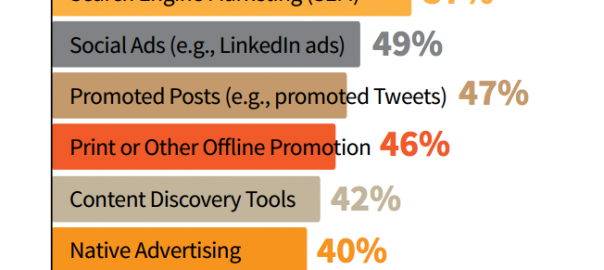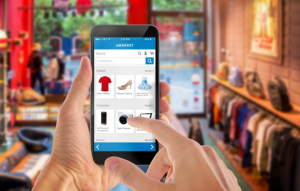As a business owner or a marketer, it’s your job to figure out the best weapons for driving traffic to your website and increasing sales. There are many tools to help you do just that, and a lot of them don’t cost a thing. Organic marketing methods, such as creating a blog, using social media, leveraging email marketing and optimizing your website for conversion, are all no-cost (or extremely cheap) strategies.
So why are so many marketers turning to paid advertising?
Because when executed well and paired properly with your content marketing strategy, paid advertising can yield substantial ROI and help you hit your marketing goals.
Where should you start? Between search, social, display and content discovery, there is a wealth of options to choose from. For example, what platforms should you use? How do you execute paid advertising in a way that gets the most bang for your buck?
Before You Begin…
There are a few important factors you’ll need to consider before deciding on the best paid advertising strategy. Start by taking some time to answer these 3 questions:
1. What are my high-level goals?
This is a critical question. Countless marketers dive into creating campaigns without giving an ounce of thought as to what they’re trying to accomplish. This often creates puzzling results that are impossible to measure success against.
To avoid that fate, ask yourself what you’re trying to accomplish with your paid campaigns: Are you trying to grow your blog subscribers? Generate more leads? Convert existing leads into customers? Whatever your goals are (yes, you can have more than one), knowing them inside and out will serve as a solid foundation for planning your campaigns.
2. What metrics will I use to measure results?
The next thing you must do is figure out which metrics will determine whether you are progressing toward your goals. Plus, let’s not forget that cost is always a factor here, since you’re ultimately trying to get the greatest dollar value out of your campaigns than what you put into them. Metrics are your best bet for determining that all-important ROI.
Here are a few useful metrics to track in your advertising campaigns (pick out the ones that will be top progress indicators):
- Click-through rate (CTR): A percentage showing how many times your ads are clicked on out of the total number of impressions for the ad.
- Conversion rate: What percentage of people converted on your offer (or performed the intended action) out of those who clicked through.
- Number of new subscribers: If your goal is to grow your subscriber database, make sure you keep track of how many new subscribers are generated by your advertising campaigns.
- Cost per subscriber: Divide your total campaign spend by the number of new subscribers you’ve generated.
- Number of new leads: If your goal is to drive leads, you’ll need to keep track of how many new leads can be attributed directly to your advertising campaigns.
- Cost per lead: Divide your total campaign spend by the number of leads you’ve generated.
- Lead to customer conversion rate: If your goal is to nurture more of your leads into customers, you should focus on increasing this number.
- Cost per customer: Divide your total campaign spend by the number of customers you’ve generated.
- Total revenue: Regardless of your specific goals, you should always be tracking the amount of revenue that your campaigns generate, as this will determine your bottom-line ROI.
- Overall ROI: As with every marketing channel, you should be able to determine the overall ROI of your paid advertising. If you haven’t yet, set up an SLA system where you assign different values to various types of leads. Each value should be based on their likelihood to generate revenue.
3. What budget am I willing to spend on these campaigns?
Finally, you’ll need to decide how much budget you’re willing to put toward your paid advertising campaigns. The more budget you have, the more flexible you can be in trying different approaches and testing various channels. That being said, you can still glean valuable information from relatively low budgets. In fact, if you’re able to get good results from low-budget tests, you might be able to justify further spending.
Exploring the Advertising Ecosystem
While you may have some inclination of which advertising channels are best for your goals and audience, you won’t really know for sure until you have the data to prove it. That’s why I recommend testing a few different channels to see which ones yield the best results.
Let’s walk through some of the options you have to choose from when it comes to paid advertising. (I love this CMI chart as a jumping-off point)
Google Adwords
Google Adwords (along with other search networks like Bing and Yahoo!) allow you to run PPC (pay-per-click) campaigns by bidding on certain keywords for which you’d like your ads to appear. These ads are in text form and will appear either at the top or along the right side of the search results page.
Pros: This is a great way to target very specific search terms. If you have a strong keyword strategy and flexible budget, you may be able to drive some good traffic.
Cons: PPC ads can run up a high bill very quickly. They also present a fundamental trade-off: You can pay a lot to bid on very competitive keywords (and have a chance at higher volume results), or you can bid a small amount on less competitive keywords that will result in a very small audience.
Good choice if…: You have a decent-sized budget, you’ve done your research on the best keyword opportunities for your business and you have the resources to invest in frequent campaign optimization.
Social Media Advertising
Facebook, Twitter and LinkedIn have fantastic advertising options. Across all of these networks, you’ll have the option to run promoted posts, “boost” organic posts or run campaigns that will attract more likes and followers.
Plus, even though these platforms have grown in popularity over the last several years, they still offer an advantage for industries that have been slow to adopt them.
Pros: Social media advertisements are designed to appear native to the overall user experience. This means that fun, relevant ads will give you a pretty good shot at attracting a very engaged audience. You’ll also have a lot of options for audience targeting and ad content testing.
Cons: Depending on your business and its industry, your audience may not have a strong social media presence or lean heavily toward specific social networks. In other words, you may need to sink a bit of cash into testing where you should, well, spend more cash.
Good choice if…: Your target audience is highly engaged in the social media space. Choose campaigns that align closely with your overall goals and (if budget allows) test a few campaigns on each social network to see which yields the lowest cost.
Display Advertising
A more “traditional” advertising option, display ads are a way to showcase your product or message across various websites. Here’s how it works: Affiliate sites allow you to upload banner ads in various sizes. After that, those ads will become available to other website owners who can display the ads on their sites for a cut of the profit.
You’ll either pay per impression or per click of your ads. If you have the option, pay per click, since it means viewers actually saw your ad and took action.
Pros: Display ads can be a good fit for visual products or messages. They may also be effective for B2C and ecommerce businesses.
Cons: Banner ads often get low CTR. This means they can become quite expensive if they’re not generating the results you want. Banner ads also tend to be viewed as a highly intrusive form of advertising.
Good choice if…: You have the budget to test a number of options and the resources to create well-designed banner ads.
Content Discovery
If you’re looking to drive traffic to your blog or your website, content discovery platforms are a great option. Platforms like Outbrain and Taboola help amplify your reach by placing links to your blog posts in the “Recommended Posts” or “Suggested Content” sections at the bottom of other sites’ blog posts.
Pros: Sharing your content through these content discovery services can get your brand great exposure on top sites, such as CNN, Slate.com, and Inc.com. They can also make a real dent in your traffic and lead generation goals.
Cons: You may have to test a number of different pieces of content to find the ones that attract the most clicks. This option is also very traffic-focused, so prioritize a different paid advertising method if you’re focused on conversion.
Good choice if…: You’re looking to grow your subscribers and get more traffic with a fairly robust arsenal of content at your disposal.
While these are the big buckets of paid advertising channels, there are several more options within each one. “Testing” is the name of the game, and I encourage you to keep testing new channels, different ads and audience targeting. Above all, track those metrics closely throughout. By the end, you’ll be well on your way to collecting very informative data (and results) on your audience.
(287)







